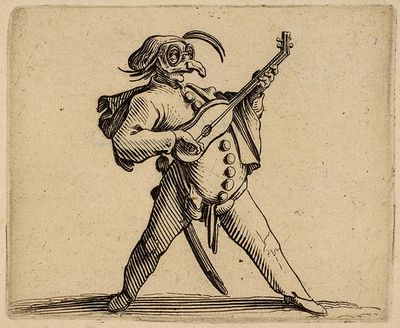Annotation:Punch Alive: Difference between revisions
(Created page with "=='''Back to [[{{BASEPAGENAME}}]]'''== ---- <p><font face="garamond, serif" size="4"> '''PUNCH ALIVE.''' English, Country Dance Tune (cut time). C Major. Standard tuning (fidd...") |
m (Text replacement - "garamond, serif" to "sans-serif") |
||
| (4 intermediate revisions by one other user not shown) | |||
| Line 1: | Line 1: | ||
=='''Back to [[{{BASEPAGENAME}}]]'''== | =='''Back to [[{{BASEPAGENAME}}]]'''== | ||
---- | ---- | ||
<p><font face=" | <p><font face="sans-serif" size="4"> | ||
'''PUNCH ALIVE.''' English, Country Dance Tune (cut time). C Major. Standard tuning (fiddle). AB. The melody and dance directions were printed in the '''Third Volume of the Dancing Master''' (2nd edition) of 1722, which was at that time being printed by John Young, heir to the Playford publishing concerns in London. It was also published by John Walsh & Joseph Hare, rival London music publishers, in their '''New Country Dancing Master, Third Book''' (1728, p. 145). | '''PUNCH ALIVE.''' English, Country Dance Tune (cut time). C Major. Standard tuning (fiddle). AB. The melody and dance directions "Longways for as many as will") were printed in the '''Third Volume of the Dancing Master''' [http://www.izaak.unh.edu/nhltmd/indexes/dancingmaster/] (2nd edition) of 1722, which was at that time being printed by John Young, heir to the Playford publishing concerns in London. It was also published by John Walsh & Joseph Hare, rival London music publishers, in their '''New Country Dancing Master, Third Book''' (1728, p. 145). | ||
<br> | <br> | ||
<br> | <br> | ||
[[File:punch3.jpg|400px|thumb|left|Jacques Callot. Punchinello Figure. French, 1616.]] | |||
The earthy character of Punch, long a mainstay of street and fair puppet shows, was introduced in England from Italy (where it was called ''Pollicinella'' or ''Punchinello'') in the mid-17th century. Pepys noted the arrival of the fat, shrill-voiced, humpbacked creature in his diary in the year 1662. Punch’s nemesis in the plays was his wife, called Joan in the early days, or the Devil, with varying results: sometimes he lost, sometimes he emerged victorious [Simpson & Roud, 2000]. | The earthy character of Punch, long a mainstay of street and fair puppet shows, was introduced in England from Italy (where it was called ''Pollicinella'' or ''Punchinello'') in the mid-17th century. Pepys noted the arrival of the fat, shrill-voiced, humpbacked creature in his diary in the year 1662. Punch’s nemesis in the plays was his wife, called Joan in the early days, or the Devil, with varying results: sometimes he lost, sometimes he emerged victorious [Simpson & Roud, 2000]. | ||
<br> | <br> | ||
<br> | <br> | ||
</font></p> | </font></p> | ||
<p><font face=" | <p><font face="sans-serif" size="4"> | ||
''Source for notated version'': | ''Source for notated version'': | ||
<br> | <br> | ||
<br> | <br> | ||
</font></p> | </font></p> | ||
<p><font face=" | <p><font face="sans-serif" size="4"> | ||
''Printed sources'': Kidson ('''Old English Country Dances'''), 1890; p. 4. | ''Printed sources'': Kidson ('''Old English Country Dances'''), 1890; p. 4. | ||
<br> | <br> | ||
<br> | <br> | ||
</font></p> | </font></p> | ||
<p><font face=" | <p><font face="sans-serif" size="4"> | ||
''Recorded sources'': <font color=teal></font> | ''Recorded sources'': <font color=teal></font> | ||
</font></p> | </font></p> | ||
Latest revision as of 14:36, 6 May 2019
Back to Punch Alive
PUNCH ALIVE. English, Country Dance Tune (cut time). C Major. Standard tuning (fiddle). AB. The melody and dance directions "Longways for as many as will") were printed in the Third Volume of the Dancing Master [1] (2nd edition) of 1722, which was at that time being printed by John Young, heir to the Playford publishing concerns in London. It was also published by John Walsh & Joseph Hare, rival London music publishers, in their New Country Dancing Master, Third Book (1728, p. 145).

The earthy character of Punch, long a mainstay of street and fair puppet shows, was introduced in England from Italy (where it was called Pollicinella or Punchinello) in the mid-17th century. Pepys noted the arrival of the fat, shrill-voiced, humpbacked creature in his diary in the year 1662. Punch’s nemesis in the plays was his wife, called Joan in the early days, or the Devil, with varying results: sometimes he lost, sometimes he emerged victorious [Simpson & Roud, 2000].
Source for notated version:
Printed sources: Kidson (Old English Country Dances), 1890; p. 4.
Recorded sources:
